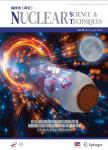How accurately can we predict synthesis cross sections of superheavy elements?
How accurately can we predict synthesis cross sections of superheavy elements?作者机构:GANIL CEA/DRF-CNRS/IN2P3 Caen France Normandie Universite Unicaen Caen France Irfu-CEA Universite Paris-Saclay Gif-sur-Yvette France RCNP Osaka University Ibaraki-shi Japan School of Science Huzhou University Huzhou 313000China
出 版 物:《Nuclear Science and Techniques》 (核技术(英文))
年 卷 期:2018年第29卷第12期
页 面:15-20页
核心收录:
学科分类:08[工学] 0807[工学-动力工程及工程热物理] 0827[工学-核科学与技术] 0703[理学-化学] 0702[理学-物理学] 0801[工学-力学(可授工学、理学学位)]
基 金:supported in part by the NSF of China(Nos.11747312,U1732138,11790325,11790323) the Joint International Laboratory between France and Japan(LIA FJNSP)
主 题:超重元素 合成 预言 十字节 地能 模型 精确性 数量级
摘 要:Synthesis of superheavy elements beyond oganesson is facing new challenges as new target–projectile combinations are necessary. Guidance from models is thus expected for future experiments. However, hindered fusion models are not well established and predictions in the fission barriers span few MeVs. Consequently, predictions are not reliable. Strategies to constrain both fusion hindrance and fission barriers are necessary to improve the predictive power of the models. But, there is no hope to get an accuracy better than one order of magnitude in fusion–evaporation reactions leading to superheavy elements synthesis.



